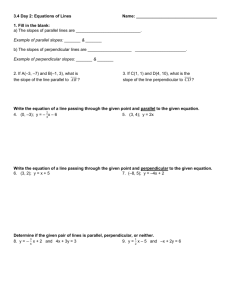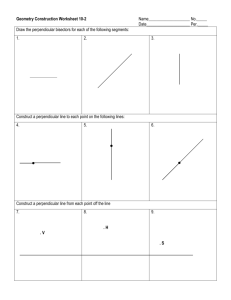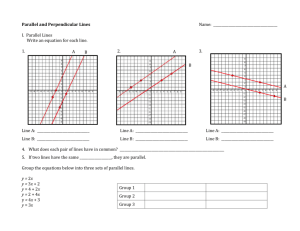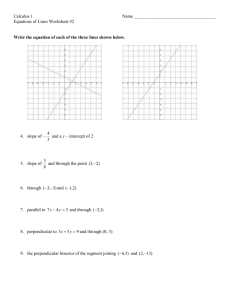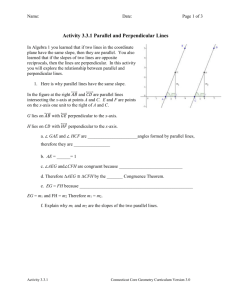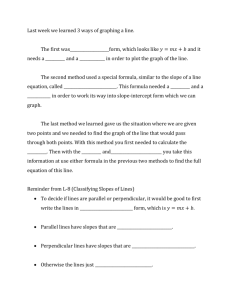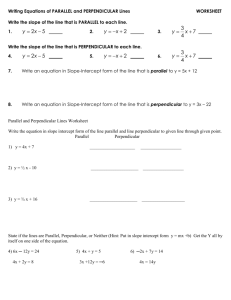ParallelPerp_Final - EMS472-572-Spring-2012
advertisement
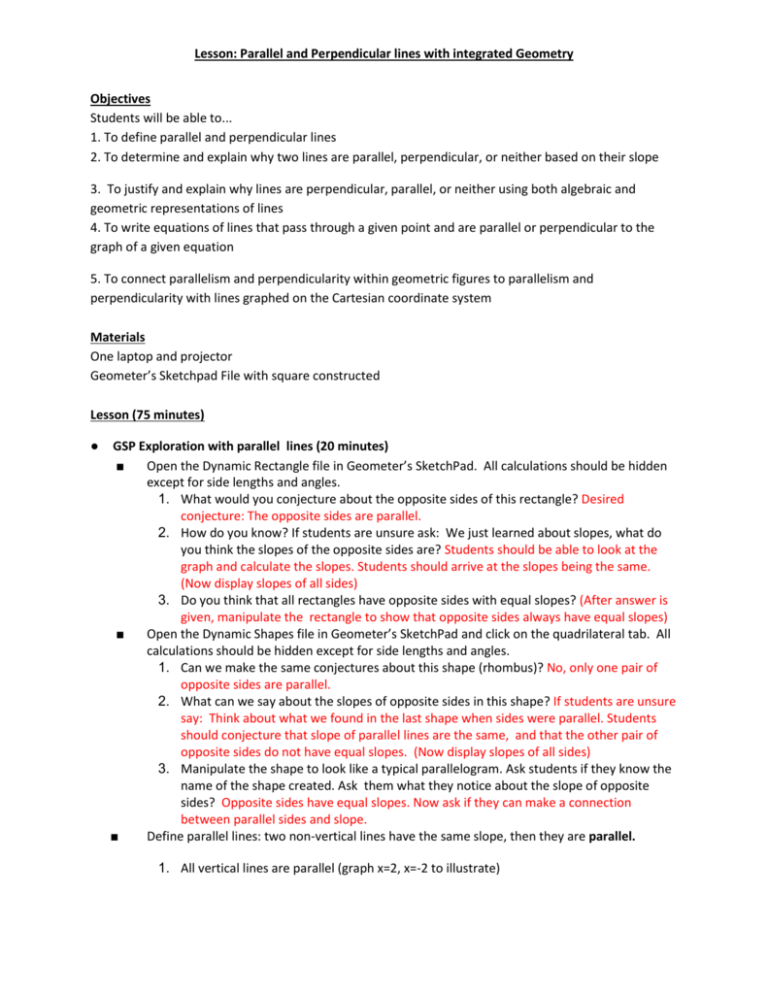
Lesson: Parallel and Perpendicular lines with integrated Geometry Objectives Students will be able to... 1. To define parallel and perpendicular lines 2. To determine and explain why two lines are parallel, perpendicular, or neither based on their slope 3. To justify and explain why lines are perpendicular, parallel, or neither using both algebraic and geometric representations of lines 4. To write equations of lines that pass through a given point and are parallel or perpendicular to the graph of a given equation 5. To connect parallelism and perpendicularity within geometric figures to parallelism and perpendicularity with lines graphed on the Cartesian coordinate system Materials One laptop and projector Geometer’s Sketchpad File with square constructed Lesson (75 minutes) ● GSP Exploration with parallel lines (20 minutes) ■ Open the Dynamic Rectangle file in Geometer’s SketchPad. All calculations should be hidden except for side lengths and angles. 1. What would you conjecture about the opposite sides of this rectangle? Desired conjecture: The opposite sides are parallel. 2. How do you know? If students are unsure ask: We just learned about slopes, what do you think the slopes of the opposite sides are? Students should be able to look at the graph and calculate the slopes. Students should arrive at the slopes being the same. (Now display slopes of all sides) 3. Do you think that all rectangles have opposite sides with equal slopes? (After answer is given, manipulate the rectangle to show that opposite sides always have equal slopes) ■ Open the Dynamic Shapes file in Geometer’s SketchPad and click on the quadrilateral tab. All calculations should be hidden except for side lengths and angles. 1. Can we make the same conjectures about this shape (rhombus)? No, only one pair of opposite sides are parallel. 2. What can we say about the slopes of opposite sides in this shape? If students are unsure say: Think about what we found in the last shape when sides were parallel. Students should conjecture that slope of parallel lines are the same, and that the other pair of opposite sides do not have equal slopes. (Now display slopes of all sides) 3. Manipulate the shape to look like a typical parallelogram. Ask students if they know the name of the shape created. Ask them what they notice about the slope of opposite sides? Opposite sides have equal slopes. Now ask if they can make a connection between parallel sides and slope. ■ Define parallel lines: two non-vertical lines have the same slope, then they are parallel. 1. All vertical lines are parallel (graph x=2, x=-2 to illustrate) Lesson: Parallel and Perpendicular lines with integrated Geometry 2. Question: Will parallel lines ever intersect? How do you know? Answer: If two unique lines are parallel then they will not intersect. Since both lines will have the same slope they will remain the same distance apart. We can see this if we draw several vertical lines. Every vertical line intersects each parallel line once. The distance between these intersection points is always the same because the parallel lines have the same slope so the lines are never getting closer to each other and will never intersect. ● GSP Exploration with Perpendicular lines (20 minutes) ■ Pull up the Dynamic Rectangle file in Geometer’s SketchPad. All calculations should be hidden except for side lengths and angles. 1. What would you conjecture about adjacent sides of this square? Desired conjecture: The adjacent sides are perpendicular. 2. How could you justify that claim? Since it’s a 90 degree angle, it must be perpendicular. 3. Is there any other way we can tell that adjacent sides are perpendicular? What can we say about the slopes of adjacent sides in this shape? Students should be able to look at the graph and calculate the slopes. Students should arrive at the slopes being opposites or negative reciprocals. (Now display slopes of all sides) ○ Ask students: what is a negative reciprocal? A reciprocal is when the numerator and denominator of a fraction are switched. So the reciprocal of 3/4 is 4/3, the reciprocal of ¼ is 4, and the reciprocal of 5 is 1/5. The negative reciprocal is found by changing the sign. If it is negative already, change it to positive. If it is positive, change it to negative. ■ ● 4. Does this slope relationship hold for all adjacent sides of rectangles? After answer is given, manipulate the rectangle to show that adjacent sides always have negative reciprocal slopes, this can be clearly demonstrated by displaying the calculation of the product of adjacent sides in GSP so that the students can see it is always -1. Pull up the Dynamic Shapes file in Geometer’s SketchPad and click the triangle tab. All calculations should be hidden except for side lengths and angles. 1. Can we make the same conjectures about this shape (right triangle)? yes, the legs of the right triangle are perpendicular 2. What can we say about the slopes of legs in this triangle? Students should conjecture that slope of the legs are negative reciprocals. Manipulate the triangle to show that this is true for all right triangles. Again display the calculation of the product of the slopes of the legs so students can see it is always -1. Define perpendicular lines: If the product of the slope of two lines is -1 then the lines are perpendicular (textbook definition) ○ Alternate definition: Given a line, another line will be perpendicular to that line if it’s slope is the negative reciprocal of the slope of the given line Parallel, Perpendicular via examples (20 minutes) Lesson: Parallel and Perpendicular lines with integrated Geometry Example: Write the slope-intercept form of an equation of the line that passes through the given point and is parallel to the graph of each equation. (Teacher does 1 on board step-bystep, students try 2 independently, teacher reviews) 1. (3,2) y= x + 5 y=x-1 2. (-3,4) 3y = 2x - 3 o y = (2/3)x + 6 Give an example of two perpendicular lines (y=2x+2 and y= -1/2x-2) 1. Given examples: if two lines had slopes -3, and ⅓ would they be perpendicular? (yes because they are negative reciprocals OR (-3 )*( ⅓) = -1) 2. What about two lines with slopes 2 and ½? (No. They are reciprocals but not negative reciprocals OR (2)*(1/2) = 1 which does not equal -1. Illustrate if necessary) ○ Example: Write the slope-intercept form of an equation of the line that passes through the given point and is perpendicular to the graph of each equation. (Teacher does first example on board, students try second example independently, teacher reviews) 1. (-1,-4) 9x + 3y = 8 y = (1/3)x - (11/3) 2. (-2,5) y = -4x + 2 y = (1/4)x + (11/2) Example: For the set of points write down the slope of a line that passes through each set. Are the lines L1 and L2 parallel, perpendicular, or neither? 1. L1: (3,1) (5,3) 2. L1: (0,2) (1,4) L2: (-2,1) (0,3) (answer: slope =1; parallel) L2: (4, -4) (-2, -1) (answer: slope = 2, -1/2; perpendicular) 3. L1: (2,3) (-1,4) L2: (0,1) (2, 5) (answer: slope = -1/3, 2; neither) 4. L1: (3,4) (3,9) L2: (1,7) (4,7) (answer: slope undefined, slope=0; perpendicular) Independent Practice (15 minutes) o Page 366 #1, 6-41 multiples of 3, 47 Closure (1-2 minutes) – Have students answer the following questions on an exit ticket, ask them to finish the rest of independent practice for HW. o Ask: What is the definition of a parallel line? What is the definition of a perpendicular line? Lesson: Parallel and Perpendicular lines with integrated Geometry o example: Are ⅔ and -3/2 negative reciprocals? (yes) What about ⅕ and 5? (no) Review and discuss that we can now find lines that are parallel and perpendicular to given lines and points.
